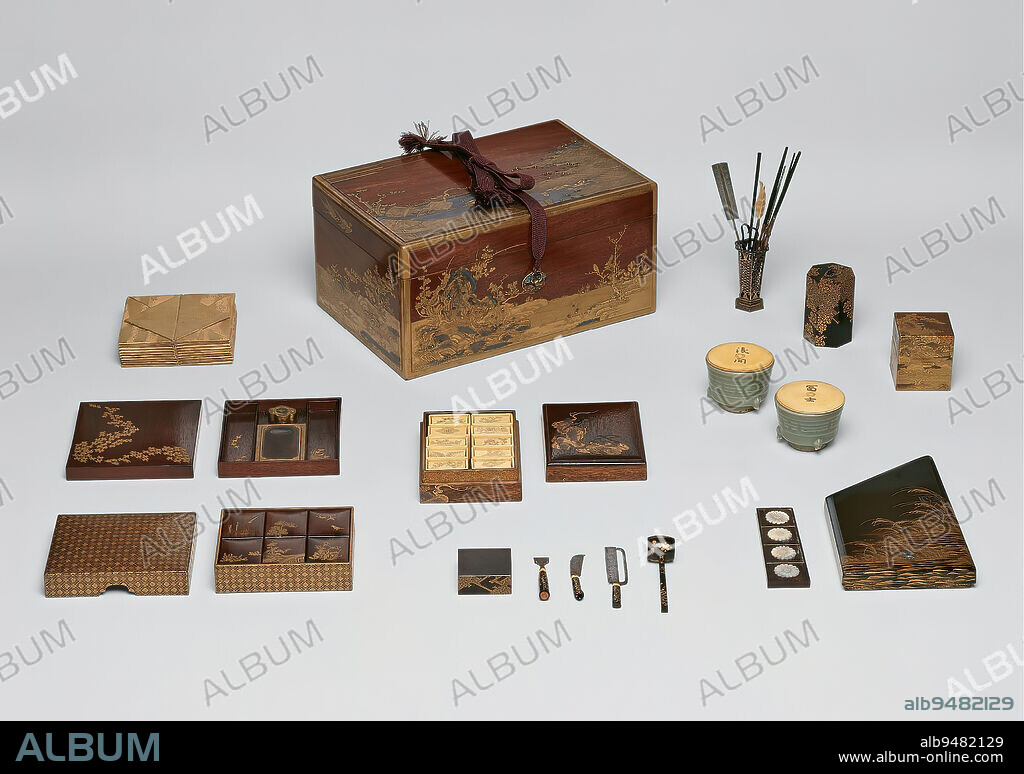alb9482129
Box and assorted implements for the incense game, 17th-18th century, Unknown Japanese, 6 × 11 7/8 × 8 in. (15.24 × 30.16 × 20.32 cm), Wood, lacquer, gold; metal utensils, Japan, 17th-18th century, Incense played a prominent role in aristocratic culture of ancient Japan. Aristocrats were expected to know how to mix aromatic imported woods with other plant products and compound them into burnable, fragrant incense. Popular ingredients included aloe, sandalwood, frankincense, pine, lily, cinnamon, and patchouli, among others. In the 1400s, this artful appreciation of incense developed further into the so-called Way of Fragrance, or kd, along with the Way of Tea (sad or chad) and the Way of Flowers (kad, better known in the West as ikebana). In incense-based games, played with the set displayed here, participants take turns smelling, appreciating, and guessing the ingredients of a certain type of incense. In one variation of the game called 'Genji Incense' or Genjik, types of incense or combinations thereof hint at chapters of The Tale of Genji.

|
Ajouter à une autre Lightbox |
|
Ajouter à une autre Lightbox |



Avez-vous déjà un compte? S'identifier
Vous n'avez pas de compte ? S'inscrire
Acheter cette image.
Sélectionnez l'usage:

Légende:
Voir la traduction automatique
Box and assorted implements for the incense game, 17th-18th century, Unknown Japanese, 6 × 11 7/8 × 8 in. (15.24 × 30.16 × 20.32 cm), Wood, lacquer, gold; metal utensils, Japan, 17th-18th century, Incense played a prominent role in aristocratic culture of ancient Japan. Aristocrats were expected to know how to mix aromatic imported woods with other plant products and compound them into burnable, fragrant incense. Popular ingredients included aloe, sandalwood, frankincense, pine, lily, cinnamon, and patchouli, among others. In the 1400s, this artful appreciation of incense developed further into the so-called Way of Fragrance, or kd, along with the Way of Tea (sad or chad) and the Way of Flowers (kad, better known in the West as ikebana). In incense-based games, played with the set displayed here, participants take turns smelling, appreciating, and guessing the ingredients of a certain type of incense. In one variation of the game called 'Genji Incense' or Genjik, types of incense or combinations thereof hint at chapters of The Tale of Genji.
Personnalités:
Crédit:
Album / quintlox
Autorisations:
Modèle: Non - Propriété: Non
Questions sur les droits?
Questions sur les droits?
Taille de l'image:
3240 x 2280 px | 21.1 MB
Taille d'impression:
27.4 x 19.3 cm | 10.8 x 7.6 in (300 dpi)
Mots clés:
ARISTOCRATE • ARISTOCRATES, ARISTOCRATIE • CANNELLE • FLEUR • FLEUR: LYS • FLEURS • IKEBANA • JEU • LYS • NOBLE • NOBLES • NOBLESSE • OR (METAL) • OR • OUEST • PIN PARASOL • PIN • POIRIER (GYMNASTIQUE) • UNKNOWN JAPANESE
 Pinterest
Pinterest Twitter
Twitter Facebook
Facebook Copier le lien
Copier le lien Email
Email
